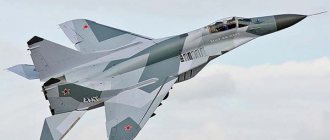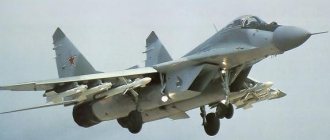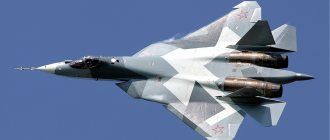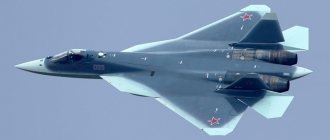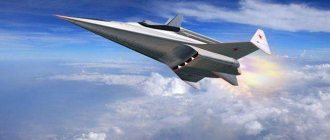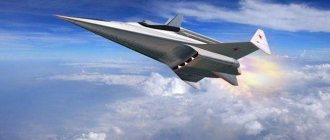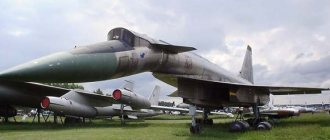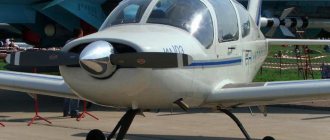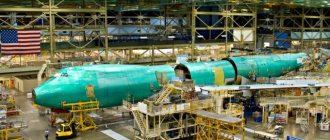SU-27, also known as “Sushka” or “Sukhar”, is a multi-role all-weather fighter. The machine belongs to the 4th generation of maneuverable combat aircraft, classified by NATO as Flanker-B, which in Russian means: strikes the flank. This aircraft was developed by the Sukhoi Development Bureau with the goal of achieving air superiority. The car turned out to be very successful and was modernized several times.
Currently, the Sushka is considered the main fighter of the Russian Air Force and is in service with several countries around the world.
History of creation
The fourth generation of mass-produced maneuverable fighters began to be created in the late 60s of the last century. Let us immediately note that the need for such aircraft arose in many countries, but the United States was the first to think about solving this problem. In particular, in 1965, American designers were tasked with creating a new tactical fighter that could replace the outdated F-4C Phantom class aircraft. As a result, the state program Fighter Experimental was launched.
As part of this program, the F-15 Eagle fighter was designed, and the aircraft manufacturing company won the tender for its creation. This happened in 1969, and 5 years later the aircraft was put into mass production.
Of course, the Soviet Union did not want to be among the laggards, so several design bureaus immediately received government orders to create a new front-line fighter. It is noteworthy that the Sukhoi Design Bureau initially did not take part in this, however, the success of the United States in creating a new promising fighter pushed the designers of this bureau to their own developments.
This is how the project with the working index T-10 appeared. These developments received official status in 1971.
A year later, scientific and technical councils were held with representatives of the Sukhoi, Mikoyan and Yakovlev design bureaus. As a result, the projects of new Yak fighters were withdrawn from the competition. The work of Sukhoi and Mikoyan was continued. As a result, the commission decided that the country would need two fighters with the most standardized equipment in order to reduce production costs.
This is how two aircraft with unique combat characteristics got their start in life: the SU-27 and the MiG-29.
J-11: Chinese "relative"
In 1990, the Su-27 was included in the list of USSR military equipment allowed for delivery abroad. And already in 1992, China became the first foreign country to purchase the Su-27, thereby significantly strengthening the power of the Air Force of the National Liberation Army of China. According to reviews of the time, Chinese pilots were shocked by the new Russian technology.
In 1996, the governments of the two countries signed an agreement to assemble 200 fighters in China from Russian components as part of a large-scale modernization program for the Chinese Air Force. The first production samples of the Chinese assembly called “J-11” took to the skies in 1998. The Russian side supplied 105 Su-27 kits for assembly under the agreement. China refused further supplies, choosing the path of independent development of the basic model. The modified J-11 became one of the main front-line fighters of the Chinese Air Force for 15 years.
In addition to its own developments, China continued to purchase more modern versions of the Su-27 from Russia. Thus, in 1999, a model of the two-seat Su-30MKK fighter was developed specifically for China. Having studied this aircraft and using the J-11B modification as a base, the Chinese created a more modern all-weather strike fighter, the J-16. This “second cousin” of the Su-27 has been in production since 2012 and, according to available data, may belong to the 4++ generation fighters.
When was it adopted?
Serial production of the SU-27 began in 1981. Assembly began in the workshops of the Komsomolsk-on-Amur aircraft manufacturing plant. Power plants were produced by two production enterprises: Moscow Machine-Building and Ufa Engine-Building. The SU-27 entered service in 1985, however, flight tests were carried out in field conditions for 5 years.
On a note! The fighter was officially put into service only in 1990, when the designers eliminated all the identified deficiencies.
Su-30: tandem 4 plus
The two-seat Su-30 fighter was a further development of the “twenty-seventh” family and belongs to the 4+ generation. A prototype of the aircraft made its first flight in 1988, and in the 1990s, an export version, the Su-30MK, was created on its basis, which was put into production in two main modifications.
The most “advanced” of them is the Su-30MKI. Among its new products is a phased array radar, which provides automatic detection and tracking of targets at long distances and in close combat. In addition, the Su-30 is equipped with powerful electronic warfare systems for self-defense, both from enemy fighters and air defense systems.
The addition of a second operator pilot to the Su-30MK crew made it possible to divide responsibilities and reduce the workload on the pilots. AL-31FP engines with deflectable thrust vectoring help perform complex maneuvers in the air.
The Su-30MK was originally created with the world market in mind, and its export modifications are currently operated by the air forces of 12 countries. Foreign Su-30s have more than once met similar NATO aircraft in exercises and have invariably shown a high level of combat performance. Su-30SM are currently being actively supplied to the Russian Aerospace Forces. In 2016, the Russian Knights aerobatic team began operating these aircraft.
Prototypes
It is quite natural that the SU-27 was not originally created in the form in which the whole world knows it. The design bureau created several prototype modifications, which identified and eliminated shortcomings in flight characteristics.
- The first in this line was an aircraft with the factory designation T-10-1, which took off in 1977. The fighter was piloted by Vladimir Ilyushin. No armament was installed on this modification; in total, the aircraft made 38 sorties as part of flight tests. As part of experimental flights, the vehicle's stability and control functionality were tested.
- The second modification received the index T-10-2 and was announced for testing in 1978. The car was piloted by Evgeny Solovyov, Hero of the Soviet Union. According to the program, the longitudinal control coefficient was checked. The tests ended unsuccessfully: the plane collapsed in the air, the pilot died.
- The third model received more efficient engines, the fourth - an innovative Sword class radar system. After flight tests in 1979, a trial batch of 5 vehicles was produced, on which control systems and weapons were tested.
However, during the tests, many shortcomings that were missed at the design stage surfaced. In particular, the installed electronics disrupted the alignment of the fighter. Aeroelasticity indicators did not correspond to theory, fuel consumption exceeded the specified values. In addition, information has been received that the American F-15 is superior to the Soviet design in many respects.
Taking these features into account, Soviet aircraft designers had two options for solving the problem: modifying the existing experimental model or creating a new aircraft. It was decided to create the aircraft from scratch, using the experience of previous developments. As a result, “Sushka” has undergone significant changes in terms of appearance and technical characteristics.
In fact, nothing remained from the previous modification. However, the designers managed to cope with the task: the new modification was superior to the American fighter.
Features of the Su-27SM aircraft
The front part of the vehicle had a built-on part, which housed a compartment for the radar, a section for the chassis and a crew cabin. On-board equipment was also located here. Two turbojet engines, which are equipped with controlled air intakes, were attached to the cockpit compartment of the aircraft. The fuselage tail and special ventral ridges are attached to the vehicle's nacelles. An increase in the aerodynamic properties of the aircraft was achieved through an integral body system. In addition, it made it possible to increase the space for fuel tanks and additional equipment. The wing design was also new. It was made in an ogival design and equipped with a reinforced root overlay.
The Su-27SM aircraft was the first to implement a new concept of longitudinal instability in subsonic flight conditions. This system provides balancing through automation, which is built on the principle of quadruple redundancy of systems. As for the landing system, a standard three-legged scheme was initially used. But it did not provide the required load distribution, after which the designers used a simplified so-called bicycle scheme, which was equipped with a weight distribution system.
Design features of the SU-27
Let's look at the main components of this model of the Soviet fighter.
Airframe device
This element is built according to an integrated scheme, when the wing is articulated with the fuselage, forming a single load-bearing base. In order to improve aerodynamics, the wing received root beads that increase sweep, which improves flight characteristics at supersonic speeds. The horizontal tail is presented in the form of a fully deflectable console, which performs the functions of roll control and elevator.
Technically, the Sushki airframe consists of the following parts:
- Nasal;
- Middle;
- Tail.
A recognizable shape is ensured by a central beam protruding beyond the engine nozzles.
Engines
The SU-27 is powered by dual-circuit turbojet engines, known as AL-31F. This line of afterburning engines was designed in the late 70s, serial production began in 1985 after comprehensive testing. The engines are installed in nacelles located at the tail of the fighter.
Power plant layout:
- Compressors with 4 and 9 stages of low and high pressure, respectively;
- Afterburner;
- Cooling turbine with high and low pressure stages.
The declared mass of the power unit is 1,490 kilograms, the declared thrust is 12,500 kgf. Equally spaced installation of engines increases stabilization and overall survivability of the aircraft in the air. The air intakes are covered with a protective mesh, the nozzles are cooled by the air flow.
Fuel supply system
The aircraft has 5 fuel tanks: two in the wing planes and three in the fuselage. When fully loaded, the SU-27 takes on board 9,600 liters of fuel, and when partially loaded - 5,600. Aviation kerosene T-1, TS, RT is used as fuel.
The fuel supply is regulated by installed sensors, the pumps operate automatically.
Hydraulics
The hydraulic system is divided into two independent circuits with a declared internal pressure of up to 280 kg/cm3. Hydraulic supply is carried out by pumps driven by an engine drive.
The hydraulic system ensures the functionality of the following structural components:
- Steering linkage;
- Chassis drive;
- Brakes;
- Brake flap control;
- Screen flaps of air intake chambers.
Pneumatic system and chassis
The pneumatic installation is filled with liquefied nitrogen and performs two main functions: it opens the pilot’s cabin and duplicates the hydraulics, ensuring the landing gear is released in emergency cases.
The chassis design is implemented according to a three-wheel design. The central pillars are made in the form of supports with telescopic gas-oil supports. The chassis is fixed with locking elements located on the load-bearing frames.
Power supply
The voltage of the on-board network "Drying" is 200/115V with a current frequency of 400 Hz. Voltage is supplied by electric generators integrated into each power unit. The low-voltage system voltage is 27V, supplied through installed rectifiers. Autonomous power supply is provided by two batteries with a converter.
Control
This is a complex module consisting of several subsystems. Fly-by-wire control provides the following functions:
- Controls the position of the bead in the transverse and longitudinal channel;
- Optimizes aerodynamic performance when performing maneuvers;
- Eliminates overloads at critical angles of attack;
- Reduces the load on the airframe.
The software operates in three modes:
- Flight;
- Take-off landing;
- Hard connection.
In addition, the aircraft is equipped with a limit limiter and an autopilot.
Navigation equipment
This element is implemented as a single on-board unit, consisting of the following units:
- Altimeter;
- Speed meter;
- Air signal control sensors;
- Electronic compass;
- Beacon;
- Vertical calculation system.
Communications center
To interact with ground and air objects, the aircraft is equipped with two radio stations operating on HF and VHF frequencies. Additionally, the main communication center includes P-515 and P-503B devices for internal switching and recording of pilot conversations.
Control of installed weapons and defensive system
The module is represented by three subsystems:
- Recognition of friend or foe signals;
- Device for searching and tracking a target using infrared radiation;
- Missile guidance system.
To protect the aircraft in the air the following are used:
- Active interference generator “Sorption”;
- Anti-missile jamming module APP-50, designed for 96 rounds;
- Bereza station warning about radiation exposure.
Cockpit flight equipment
Command and gliding scale flight instruments are installed here. The SU-27 is directly controlled by a handle located in the central part of the cockpit. Additional levers located on the left side are responsible for controlling the power units. Path control of pedal type.
Coloring
Typical camouflage:
- The lower part is light blue;
- The upper part has blue, light blue and gray-bluish spots.
The rockets are painted white with three black rings. The license plates are located on the front of the fuselage.
OPERATION AND COMBAT USE OF SU-27
The first in the USSR Air Force in 1984 to receive Su-27 fighters was the 60th Air Defense Fighter Regiment, stationed at the Dzemgi airfield (Komsomolsk-on-Amur). Pilots were trained on the new one at the Air Force Combat Use Centers in Lipetsk and Air Defense Fighter Aviation Centers in Savaslake.
In the West, the Su-27 fighter became widely known after the collision on September 13, 1987 of a Su-27 with a patrol P-3S of the Norwegian Air Force. "Orion" was flying over the Northern Fleet exercise area. The Soviet fighter was supposed to push him out of the exercise area. As a result of the collision, both aircraft were slightly damaged. After this event, photographs of the Su-27 with full missile armament circulated throughout the Western press.
| Performance characteristics of the Su-27 fighter | |
| Crew | 1 person |
| Power point: | Two AL-31F turbofans with afterburner thrust of 12,500 kgf (122.58 kN) |
| Dimensions, m: | |
| wingspan | 14,70 |
| length with LDPE | 21,94 |
| height | 5,93 |
| Wing area, m2 | 62 |
| Weight, kg: | |
| empty | 16 000 |
| normal takeoff | 22 500 |
| maximum takeoff | 30 000 |
| Maximum speed, km/h: | |
| at high altitude | 2500 (M=2.35) |
| near the ground | 1400 |
| Practical ceiling, m: | 18 500 |
| Maximum range, km | 3900 |
| Lift-off speed, km/h | 360 |
| Landing speed, km/h | 290 |
| Run length, m | 700 |
| Run length, m | 700 |
| Maximum operational overload | 9g |
| Weapons: | 1 30-mm GSh-301 cannon with 150 rounds of ammunition; 6 medium-range air-to-air missiles R-27R/T; 4 R-73 close-in missiles |
The Su-27, in fact, in its basic configuration, was in service with both the Air Force and fighter aircraft (IA) of the USSR air defense. Before the collapse of the Soviet Union, most of the Su-27s stationed on the European territory of the Union belonged to the air defense forces. In 1991, the USSR Air Force and Air Defense Agency had about 500 Su-27 fighters in service.
The Su-27 has been successfully demonstrated at air shows around the world. Its maneuverability allows it to perform a number of unique aerobatics (“Pugachev’s Cobra”, “Bell”). True, only pilots cleared to fly at extreme conditions can perform them. However, even without the implementation of these figures, not a single fighter in the world could compare with the Su-27 in terms of maneuverability in the 1990s. By the way, the well-known Russian Knights aerobatics team is equipped with Su-27 fighters.
Now the Su-27, along with the MiG-29, remains the main fighter of the Russian Air Force and Air Defense, and perhaps one of the most effective in the world. Currently, Russia has approximately 350 Su-27 fighters. In general, only large states can afford to have heavy fighters in their air forces en masse. Other countries, if they have similar aircraft, do so only in very modest quantities. In this regard, it is worth mentioning the unspoken confrontation between the MiG and Su in the 90s, due to the fact that the Sukhoi management strongly lobbied for the replacement of the MiG-29 fighters with the Su-27. If these plans were implemented, the fighter fleet of the Russian Air Force would consist of 100% heavy fighters, which would place too high a burden on the budget. Ultimately, about 300 twenty-niners remained in the Russian Air Force.
After the collapse of the USSR, regiments armed with Su-27 remained in Ukraine (831st IAP, Mirgorod; 136th IAP Air Defense, Kirov, Crimea; now Ukraine has 70 Su-27s, of which only 16 are operational) and Uzbekistan (9th Guards Air Defense IAP, Andijan).
Belarus “inherited” from the USSR more than 20 Su-27s that were being repaired in Baranovichi.
Kazakhstan received the Su-27 in the 1990s from Russia in exchange for the Tu-95MS strategic missile carriers. The first four Su-27s arrived in Kazakhstan in 1996.
Su-27s are in service with the Air Forces of Angola (14 units) and Eritrea (10 units). The planes were presumably supplied to Angola by Belarus. In 1998-1999, the Ethiopian Air Force was supplied with eight Su-27/Su-27UB, previously in service with the Russian Air Force.
Unlike the MiG-29, until now there have not been many cases of the Su-27 being used in real combat.
During the 1999 Ethiopian-Eritrean armed conflict, Ethiopian Su-27s clashed three times in air battles with Eritrean MiG-29s, in each of which they shot down one MiG without suffering losses. The advantage of the Su-27 in speed and maneuverability was felt. According to some reports, former Soviet pilots fought in the air on both sides (Russians on Ethiopian planes, Ukrainians on Eritrean planes). In 2000, the Eritrean Ambassador to the Russian Federation even directly stated that a number of former Soviet officers participated in the conflict on the Ethiopian side, indicating their names and military ranks.
In 2000, the Angolan Air Force lost a Su-27 fighter to ground fire.
In 1992, Georgian air defense shot down a Russian Su-27, which was on patrol in the area of the Georgian-Abkhaz conflict.
During the “five-day war” of 2008, Russian Su-27s, together with Mig-29s, controlled the airspace over South Ossetia.
The Su-27 fighter has never operated in real combat against its main competitor, the F-15. But the Su-27 had to face it in simulated battles at various air shows and joint exercises. In close combat between the Su-27 and the F-15, the Russian fighter has an unconditional advantage, easily “getting on the tail” of the American. The maneuverability and thrust-to-weight ratio of the Su-27 are significantly higher. But the F-15 avionics are considered more advanced, which could give the American fighter an advantage in long-range missile combat. However, in the Cope India 2004 exercise, where the Indian Air Force Su-27 and the US Air Force F-15C fought, the Americans looked pale, losing 2/3 of the total number of air battles. Indian pilots used unconventional tactics: they turned off the radar and approached the enemy within range of targeted cannon fire, using the optical-electronic systems of their Su-27s. True, under the terms of the exercise, the Americans did not use their AIM-120 missiles, but it was with the help of these missiles that American fighters effectively shot down MiG-29s in Yugoslavia.
Installed weapons
“Sushka” is armed with a gun and missile system. A 30-mm PSh-301 air cannon is installed here, and suspensions are provided for short- and long-range air-to-air and air-to-ground guided missiles.
- Range of destruction of air targets.
Target detection is possible at a distance of 35-100 km, simultaneous capture of up to 10 objects is ensured. Fire is fired at one target; it is possible to aim two missiles at one object.
- Range of destruction of ground targets.
The ground target detection system detects objects moving at a speed of 15-90 km/h. Surface objects are detected at a distance of 30-350 kilometers, depending on the volume of the target.
Su-27 aircraft weapons
Aerobatics performed
Here we can highlight the famous “Cobra”: the plane begins to lift up its nose, and without changing the motion vector, it increases the angle of attack to 120 degrees, then returns to normal flight mode. This element was first made on the SU-27 by Viktor Volk.
In addition, the machine performs a “Somersault” or “Frolov’s Chakra”: the “Drying” gains altitude while simultaneously slowing down and makes a loop, actually turning around the tail unit.
Su-27 performs Cobra
Su-35: transonic fighter
The Su-35 is the youngest of the “successors” of the basic Su-27. This is a deep modernization of the “twenty-seventh”, which in its characteristics, with the exception of stealth, corresponds to fifth-generation fighters. The Su-35 was developed in 2000 and today is the most modern fighter aircraft of the Russian Aerospace Forces.
During the work on this vehicle, the airframe was modernized and the on-board equipment was updated. A new information and control system, the latest Irbis radar are installed on board the Su-35, and AL-41F1S engines, even more powerful than those on the Su-30SM, are responsible for super-maneuverability. Thanks to the new engine, the aircraft can perform long-term flights at transonic speeds without using afterburner. The arsenal of combat weapons has also been expanded to include the latest long-range missiles.
In terms of its capabilities, the Su-35 is superior to most modern fighters in both close and long-range combat. The latest digital systems allow the Su-35 group to effectively interact in the air and solve complex joint tasks. The Su-35 has no restrictions on angles of attack and is super-maneuverable with high controllability. These characteristics, as well as the ability to use long-range air-to-air missiles, significantly increase the combat potential of the aircraft.
Comparison with analogues
Considering that the SU-27 was created to achieve superiority over the American F-15 fighter, it makes sense to compare these combat vehicles. Joint maneuvering of these aircraft was carried out in 1996 at the Savasleika airbase, located in the Nizhny Novgorod region. Domestic development defeated the “American”.
According to Russian pilots, the F-15 feels insecure when maneuvering at subsonic speeds.
Many experts often compare the SU-27 and MiG-29, because both aircraft were developed within the same project. However, this is not entirely fair, because we are talking about vehicles of different classes, adapted to perform specific combat missions. It can be clarified that the SU-27 is more maneuverable than its brother, despite its greater structural weight. Valery Menitsky, chief pilot of the MiG design bureau, does not agree with this statement. The pilot claims that the advantage of the Sushka is given by artificial restrictions on the angle of attack.
Many experts often compare the SU-27 and MiG-29
Su-33: folding wings for naval aviation
The deck version of the Su-27 was created by order of the Navy to protect the fleet from air attack. The aircraft was accepted into service in 1998. For hangar storage on an aircraft carrier, the aircraft is equipped with a folding wing and stabilizer system. In addition, it is distinguished from the basic model by reinforced landing gear and the presence of a brake hook, which, when landing on the deck, clings to the arresting device cable and stops the aircraft. In addition to performing combat missions, the Su-33 can be equipped with an outboard refueling unit and used as a tanker.
In 1989, the Su-33 made the first conventional landing in Russian history on the deck of an aircraft carrier. A total of 26 serial fighters were built, some of them are still based on the Russian Navy heavy aircraft-carrying cruiser Admiral Kuznetsov. As part of the Admiral Kuznetsov air group, fighters were used in operations of the Russian armed forces in Syria.
Known modifications
The following aircraft were built on the basis of the serial SU-27:
- SU-27-IB - two-seat fighter-bomber;
- SU-27-M - multi-purpose;
- SU-27-P - interceptor;
- SU-27-SK - export modification for commercial use;
- SU-27-SM - a modernized variation of the serial fighter;
- SU-27-SMZ and SU-27-SKM - export versions;
- SU-27-Ub - combat training aircraft;
- SU-27-UBK - export version of the previous model;
- SU-30 - two-seat interceptor;
- SU-33 is a carrier-based fighter with a folding wing and tail unit;
- SU-33-UB is a training aircraft with side-by-side pilot seats;
- SU-34 - fighter-bomber with row seats;
- SU-35-S is a multi-role fighter without a front horizontal tail;
- SU-37 - was built in one copy, crashed during a test flight;
- P-42 - uprated engine and reduced take-off weight.
SU-30
FIGHTER INTERCEPTOR SU-27
DIMENSIONS. Wingspan - 14.7 m; aircraft length (without PVD rod) —
21.94 m; aircraft height - 5.93 m (Su-27UB - 6.36 m); wing area - 62.04 m'.
WEIGHTS AND LOADS, kg. Normal take-off 23,000 (with incomplete fuel filling in the air superiority fighter configuration, Su-27UB - 24,000), maximum take-off 28,000 (Su-27UB - 30,500), empty 16,300 (Su-27UB - 17,500). fuel in internal tanks is 9400, maximum combat load is 4000.
POWER POINT. Two AL-31F turbofan engines (2×12500 kgf).
The total capacity of the internal fuel tanks (three in the fuselage and two in the wing consoles) is 11975 liters. An incomplete refueling option (6680 l) is provided, in which the front fuselage and two wing fuel tanks remain empty.
FLIGHT CHARACTERISTICS. Maximum speed 2500 km/m (Su-27UB - 2125 km/h); maximum ground speed 1400 km/h; service ceiling - 18500 m (Su-27UB - 17250 m); dynamic ceiling - 24000 m; maximum rate of climb - 300 m/s; practical range 3900 km "Su-27UB - 3000 km); practical range on the ground 1400 km; take-off length - 650 m (Su-27UB - 750 m); run length with a braking parachute - 620 m; maximum steady overload - 9.0.
The CREW, consisting of one or two (on the Su-27UB) people, is placed in K-36KD ejection seats.
EQUIPMENT. The Su-27 is the first production domestic aircraft equipped with an electronic remote control system (analog, with quadruple redundancy).
The coherent pulse-Doppler radar sighting system RLPK-27 with N001 radar provides detection and tracking of air targets both in free space and against the ground, tracking “on the pass” to K) targets with the issuance of target designation for firing at one target. Target detection range with EPR = 3 h 2
is 100 km in the front and 40 km in the rear hemispheres.
The OEPS-27 optical-electronic sighting station includes a heat direction finder with day and night channels, as well as a laser rangefinder. The fighter is equipped with instrument guidance equipment via a noise-proof line, which carries out targeting in a director and automatic mode according to commands from a ground-based launcher.
The airborne defense complex (ADS) includes a radio reconnaissance and radiation warning station, an active jamming station and a pyrotechnic passive jamming device.
WEAPONS. The Su-27 fighter is equipped with a GSh-301 cannon (30 mm, 150 rounds). 10 underwing and ventral hardpoints can accommodate up to 10 air-to-air missiles, including up to six medium-range missiles R-27R and R-27T, up to two extended-range missiles R-27ER and R-27ET. Some aircraft (including the Su-27S) can also carry unguided weapons for operations against ground targets. The maximum combat load is 4000-6000 kg.
ADDITIONAL INFORMATION. In 1971, the P.O. Sukhoi Design Bureau began design work to create a promising front-line fighter (PFI). By 1974, with the participation of TsAGI specialists, the aerodynamic and design-power schemes of the aircraft (received the working index T-10) were finally formed. Construction of the first prototype aircraft began in 1976, and on May 20, 1977, the fighter took off for the first time. Subsequently, the aerodynamic appearance and design of the car were significantly revised. A modified fighter - T-10S (Su-27 prototype) - took off on April 20, 1981, and in 1982 serial production of aircraft began in Komsomolsk-on-Amur.
The first experimental two-seat combat trainer T-10U made its first flight on May 7, 1985. Serial production of the Su-27UB began at the Irkutsk Aviation Plant in 1986. By 2000, a total of more than 760 serial Su-27 and Su-27UB.
In the 1990s. Work began on modernizing the fleet of Su-27 fighters of the Russian Air Force. This assumes:
— ensure the use of medium-range missiles RVV-AE, as well as air-to-surface missiles and KAB;
— introduce a mode of simultaneous attack of two targets;
— The N001 radar should be able to operate on the earth's surface (mapping, selection of moving targets, use of weapons against ground or sea targets, contour following). The aircraft will have the ability to simultaneously fire at two air targets using RVV-AE missiles. In the future, the potential of the radar can be further increased by replacing the Cassegrain antenna with a phased array antenna of the Perot type.
Work is underway to improve the aircraft's avionics. The new information and control complex is supposed to be implemented using two multifunctional liquid crystal displays with a format of 6×8 inches. It is planned to install a radio station with pseudo-random frequency tuning, a new electronic reconnaissance station with improved characteristics, an expanded data bank and the ability to issue target designations to anti-radar missiles, as well as other equipment.
It is possible to adapt an integrated reconnaissance container to the aircraft, which includes equipment for television, thermal and radio reconnaissance with the ability to broadcast information in real time to a ground command post.
The number of external hardpoints will be increased from K) to 12, the maximum combat load will increase to 8000 kg, the aircraft will be able to suspend two tanks with a capacity of 2000 liters on the underwing nodes.
Work is underway to create a more powerful version of the AL-31F turbofan engine for the modernized Su-27 aircraft. In 2003, the Russian Ministry of Defense prepared technical specifications for the modernization of the AL-31F engine. At the first stage, the maximum thrust of the turbofan engine will be increased to 13,300 kgf. In the future, it is possible to increase it to 14,000-15,000 kgf. The modernized fighter will receive a fuel receiver rod for an in-flight refueling system. The Su-27SK variant was created for export (China, Vietnam). By the beginning of the current decade, the Russian Air Force had about 400 Su-27 and Su-27UB aircraft. About 60 more Su-27s were in the Ukrainian Air Force and 23 (including four Su-27UB) in Belarus. By the end of 1999, 14 aircraft were transferred by Russia to Kazakhstan (another 12 aircraft are planned to be delivered). About 30 Su-27s remained in Uzbekistan after the collapse of the USSR (probably most of them are currently uncombatable).
By 2000, the Chinese Air Force had 38 Su-27SK and 10 Su-27UBK aircraft. purchased in two batches in 1991-96. In addition, a license was acquired to produce 200 aircraft of this type in China at an aircraft plant in Shenyang. The first Su-27, assembled in China using Russian components, made its first flight in November 1998 (the Su-27 was designated .1-11 by the Chinese Air Force). The Vietnamese Air Force has seven Su-27SK fighters and five Su-27UBK UBS. In 1998, four Su-27 fighters, previously in service with the Russian Air Force, were acquired by Ethiopia.
On the basis of the Su-27 fighter, its two-seat combat training version Su-27UB was developed.
Table of contents
Main design characteristics of the Su-27SM aircraft
The fuselage of the vehicle consists of three main parts, namely: the nose with the cockpit, the middle, in which the fuel tanks are located, and the tail, which includes the tail booms and the central beam of the vehicle's body. The designers made extensive use of titanium, which significantly reduced the weight of the device's structure without reducing the rigidity and strength of the structure. In the manufacture of this machine, oddly enough, virtually no composite materials were used. The Su-27SM type vehicle also has a horizontal type nose tail.
The Su-27SM aircraft is the first aircraft of this type in our country, which is equipped with a remote control system. Thanks to new on-board systems, the vehicle can process information much faster and, as a result, react and execute commands much faster.
The power plant of the vehicle consists of two AL-type turbojet engines, which are equipped with afterburners. They are located in gondolas under the tail section of the vehicle. This type of engine is characterized by low fuel consumption and has excellent power characteristics in various operating modes.
The Su-27SM type device is equipped with four fuel tanks with a total capacity of more than 11 thousand liters. The tanks are located at the base of the vehicle's fuselage and in the wings. For flights, the aircraft uses aviation kerosene, which is filled through a special niche in the front leg.
To ensure all hydraulic systems of the machine, a constant oil pressure of 280 kg/cm2 is required. Both engines of the machine have independent oil pumps. In addition to engines, hydraulics are used in the chassis, braking system and steering system. In order to perform an emergency landing gear release, the Su-27SM model aircraft has an additional pneumatic system that runs on compressed nitrogen.
The chassis of the device is represented by three supports, which are made according to a telescopic design. Each support is equipped with one wheel with a brake system and gas-oil shock absorbers.
As for the power supply, the aircraft is powered by a current of 200 volts and a frequency of 400 hertz. To produce electricity, the engines are equipped with generators of the GP-21 type. The secondary power supply system operates at a voltage of 27 Volts. In the event of a generator failure, the aircraft is equipped with cadmium batteries, which are located in the nose landing gear well.
The Su-27SM type aircraft can be considered a truly high-quality combat vehicle that competes with foreign analogues.
Comparative performance characteristics
9.1 Technical specifications
- Crew, people: project (T10-1), Su-27P(S), Su-27SK, Su-27SM – 1; Su-27UB - 2
- Length, m: project (T10-1) - 18.5; Su-27P(S), Su-27SK, Su-27SM, Su-27UB - 21,935
- Wing span, m: project (T10-1) - 12.7; Su-27P(S), Su-27SK, Su-27SM, Su-27UB - 14,698
- Height, m: project (T10-1) - 5.2; Su-27P(S), Su-27SK, Su-27SM - 5,932; Su-27UB - 6,537
- Wing area, m²: project (T10-1) – 48; Su-27P(S), Su-27SK, Su-27SM, Su-27UB - 62.04
- Wing aspect ratio: project (T10-1) - 3.38; Su-27P(S), Su-27SK, Su-27SM, Su-27UB - 3.5
- Wing taper coefficient: project (T10-1) - 6.57; Su-27P(S), Su-27SK, Su-27SM, Su-27UB - 3.4
- Sweep angle: project (T10-1) - 45°; Su-27P(S), Su-27SK, Su-27SM, Su-27UB - 42°
- Chassis base, m: project (T10-1) – no data; Su-27P(S), Su-27SK, Su-27SM, Su-27UB - 5.8
- Chassis track, m: project (T10-1) - 1.8; Su-27P(S), Su-27SK, Su-27SM, Su-27UB - 4.34
- Empty weight, t: project (T10-1), Su-27SM - no data; Su-27P(S) – 16.3; Su-27SK – 16.87; Su-27UB – 17.5
- Normal take-off weight, t: project (T10-1) – 18; Su-27P(S) - 22.5; Su-27SK - 23.4; Su-27SM - 23.7; Su-27UB - 24
- Maximum take-off weight, t: project (T10-1) – 21; Su-27P(S) – 30; Su-27SK, Su-27SM – 33; Su-27UB - 30.5
- Fuel mass, kg: project (T10-1) – no data; Su-27P(S), Su-27SK - 9,400/5,240; Su-27SM, Su-27UB - 9,400/6,120
- Fuel volume, l: project (T10-1) – no data; Su-27P(S), Su-27SK - 11,975/6,680; Su-27SM, Su-27UB - 11,975/7,800
- Powerplant: two AL-31F turbofan engines
- Non-afterburning thrust, kgf (*10 N): project (T10-1) - no data; Su-27P(S), Su-27SK, Su-27SM, Su-27UB – two for 7,600
- Afterburner thrust, kgf (*10 N): project (T10-1) – two per 10,300; Su-27P(S), Su-27SK, Su-27SM, Su-27UB - two for 12,500
9.2 Flight characteristics
- Maximum speed at an altitude of 11000 m, km/h: project (T10-1), Su-27P(S), Su-27SK, Su-27SM - 2,500 (M=2.35); Su-27UB - 2,125 (M=2.0)
- Maximum ground speed, km/h: project (T10-1) - 1,400; Su-27P(S), Su-27SK, Su-27SM, Su-27UB - 1,380
- Landing speed, km/h: project (T10-1) – no data; Su-27P(S), Su-27SK, Su-27SM – 225 – 240; Su-27UB – 235 – 250
- Stall speed, km/h: project (T10-1), Su-27SK, Su-27SM, Su-27UB - no data; Su-27P(S) - 200
- Range, km (near the ground/at altitude): project (T10-1), Su-27SK, Su-27SM, Su-27UB - no data; Su-27P(S) - 440/1 680
- Practical range, km (near the ground/at altitude): project (T10-1) - 800/2,400; Su-27P(S) - 1,400/3,900; Su-27SK - 1,370/3,680; Su-27SM - no data/3,790; Su-27UB - 1,300/3,000
- Practical ceiling, m: project (T10-1) - 22,500; Su-27P(S), Su-27SK - 18,500; Su-27SM - 18,000; Su-27UB - 17,250
- Rate of climb, m/s: project (T10-1) – 345; Su-27P(S) – 285 – 300; Su-27SK, Su-27SM, Su-27UB - no data
- Take-off run length, m: project (T10-1) – 300; Su-27P(S) – 650 – 700; Su-27SK – 700 – 800; Su-27SM – 650; Su-27UB – 750 – 800
- Run length, m: project (T10-1) – 600; Su-27P(S) – 620 – 700; Su-27SK, Su-27SM – 620; Su-27UB – 650 – 700
- Wing load, kg/m²: project (T10-1) – 375; Su-27P(S), Su-27SK, Su-27SM, Su-27UB - no data
- Thrust-to-weight ratio: project (T10-1) - 1.12; Su-27P(S) - 1.2; Su-27SK, Su-27SM, Su-27UB - no data
- Minimum turn radius, m: project (T10-1), Su-27SK, Su-27SM, Su-27UB - no data; Su-27P(S) - 450
- Maximum operational overload: + 9 g
9.3 Armament
- Small arms and cannon: project (T10-1) - 30 mm AO-17A gun; Su-27P(S), Su-27SK, Su-27SM, Su-27UB - 30 mm GSh-30-1 gun
- Ammunition, sn.: project (T10-1) – 250; Su-27P(S), Su-27SK, Su-27SM, Su-27UB - 150
- Weapon suspension units: project (T10-1) – 8; Su-27P(S), Su-27SK – 10; Su-27SM – 12; Su-27UB - 10
- Combat load, kg: project (T10-1) - no data; Su-27P(S) - 6,000; Su-27SK, Su-27SM - 8,000; Su-27UB - 4,000
- Air-to-air missiles: project (T10-1) - two K-25 and six K-60; Su-27P(S), Su-27SK - six R-27 and four R-73; Su-27SM - eight R-27 or four to six R-73 and eight R-77; Su-27UB - six R-27 and four R-73
- Air-to-surface missiles: Su-27SM - six Kh-29 or six Kh-31 or two Kh-59
- Unguided aircraft missiles: project (T10-1) - no data; Su-27P(S), Su-27SK, Su-27SM, Su-27UB - eighty S-8 or twenty S-13 or four S-25
- Air bombs: project (T10-1) - no data; Su-27P(S), Su-27SK - eight per 500 kg or thirty-one per 250 kg or thirty-eight per 100 kg; Su-27SM - eight for 500 kg or thirty-one for 250 kg or thirty-eight for 100 kg or six KAB-500 or three KAB-1500; Su-27UB - 10 at 500 kg or thirty-one at 250 kg or fifty 100 kg
9.4 Avionics
- Radar station: project (T10-1) - Sapphire-23MR; Su-27P(S), Su-27SK, Su-27SM, Su-27UB - RLPK-27
- Antenna diameter, mm: project (T10-1), Su-27SM - no data; Su-27P(S), Su-27SK, Su-27UB - 975
- Air target detection range, km: project (T10-1) – 40 – 70/20 – 40; Su-27P(S), Su-27SK – 80 – 100/30 – 40; Su-27SM - no data; Su-27UB – 80 – 100/30 – 40
- Number of simultaneously tracked targets: project (T10-1), Su-27SM - no data; Su-27P(S), Su-27SK, Su-27UB - 10
- Number of simultaneously attacked targets: project (T10-1), Su-27SM - no data; Su-27P(S); Su-27UB – 1; Su-27SK - 2
- UES: project (T10-1) – yes; Su-27P(S), Su-27SK, Su-27SM, Su-27UB - OEPS-27
- Air target detection range, km: project (T10-1) - no data; Su-27P(S), Su-27SK, Su-27SM, Su-27UB - 15/50
- Height viewing area: project (T10-1) – no data; Su-27P(S), Su-27SK, Su-27SM, Su-27UB - −15°/+60°
- Azimuth viewing area: project (T10-1) – no data; Su-27P(S), Su-27SK, Su-27SM, Su-27UB — ±60°
- Helmet-mounted target designation system: project (T10-1) – yes; Su-27P(S), Su-27SK, Su-27SM, Su-27UB - “Schel-3UM”
